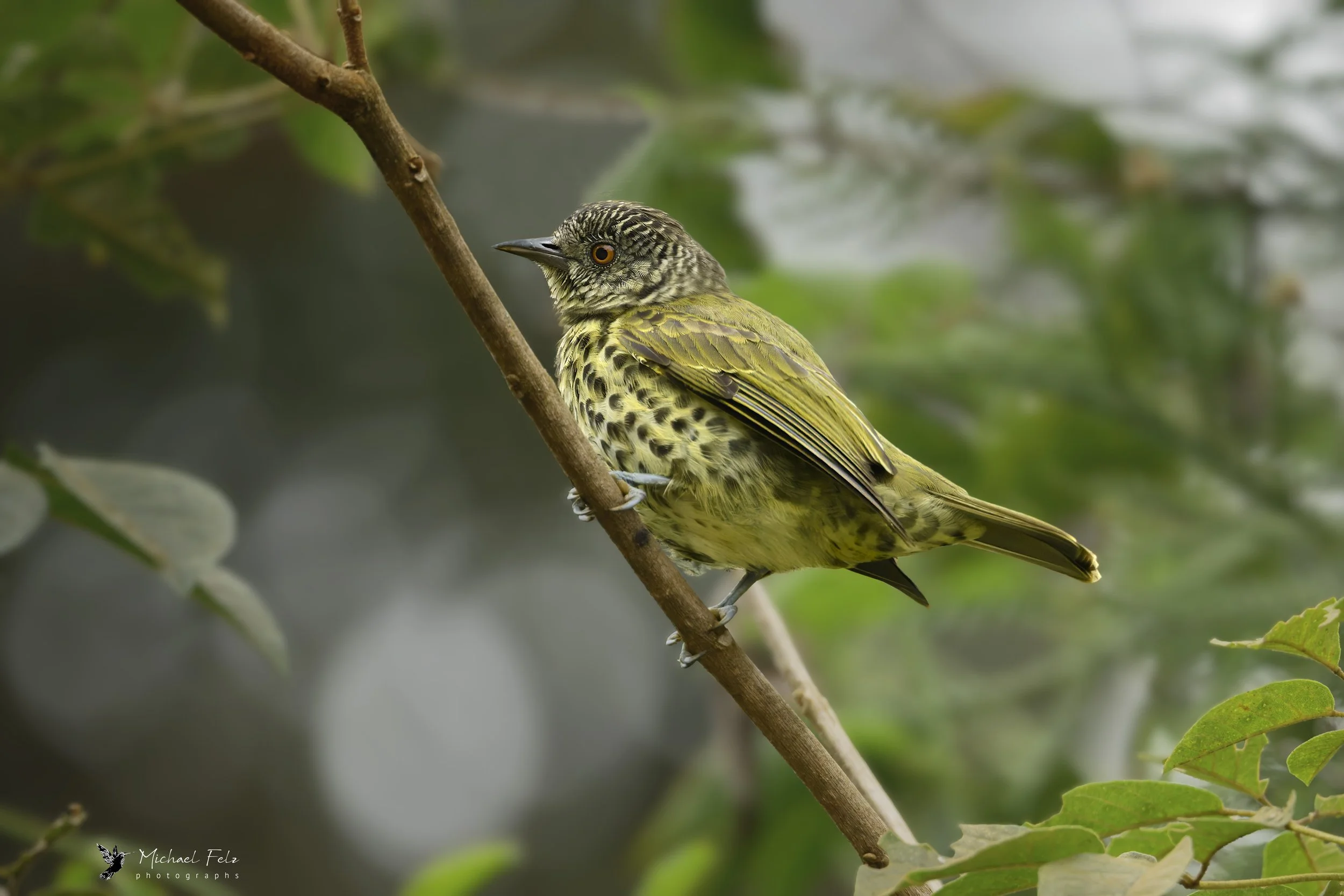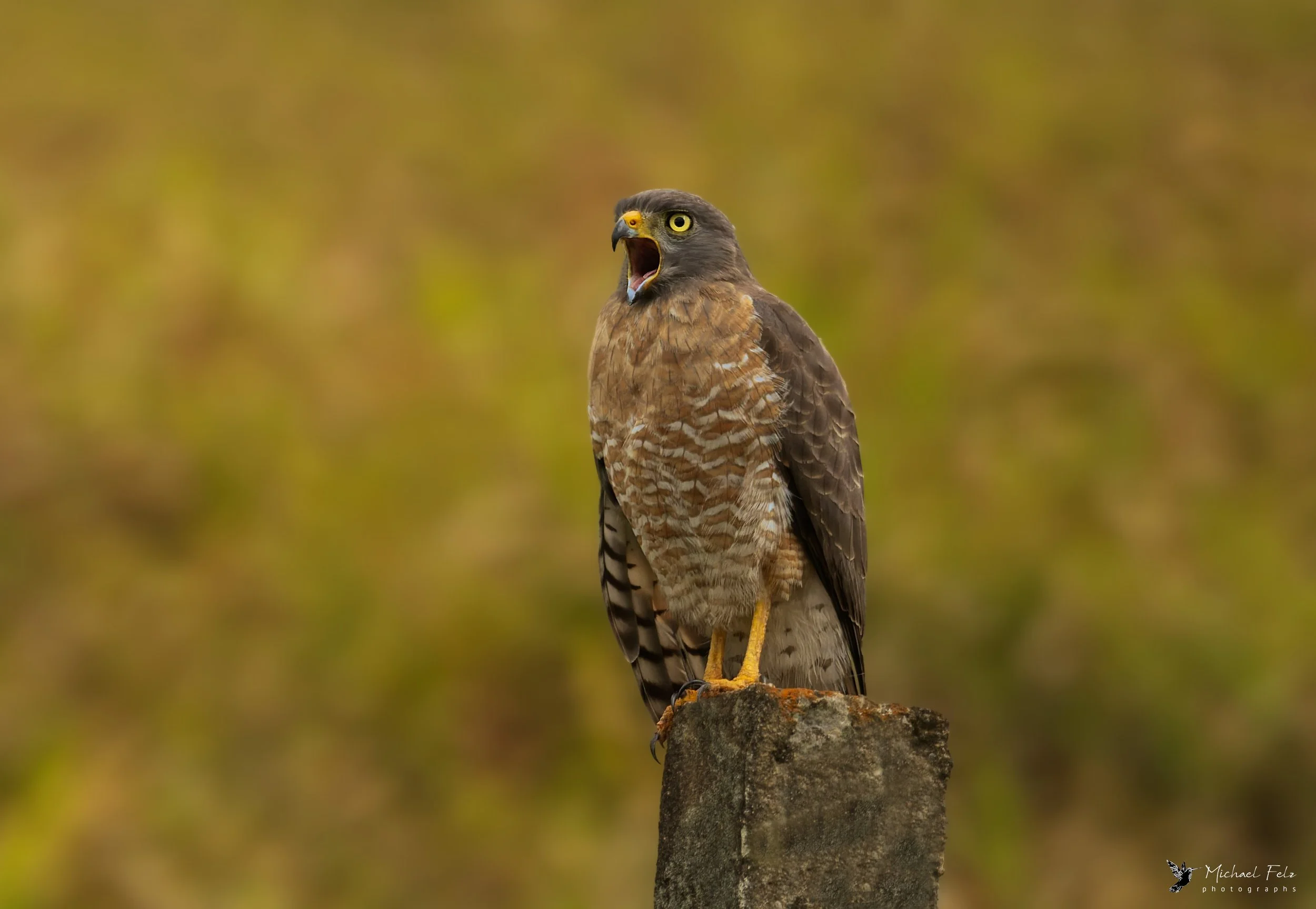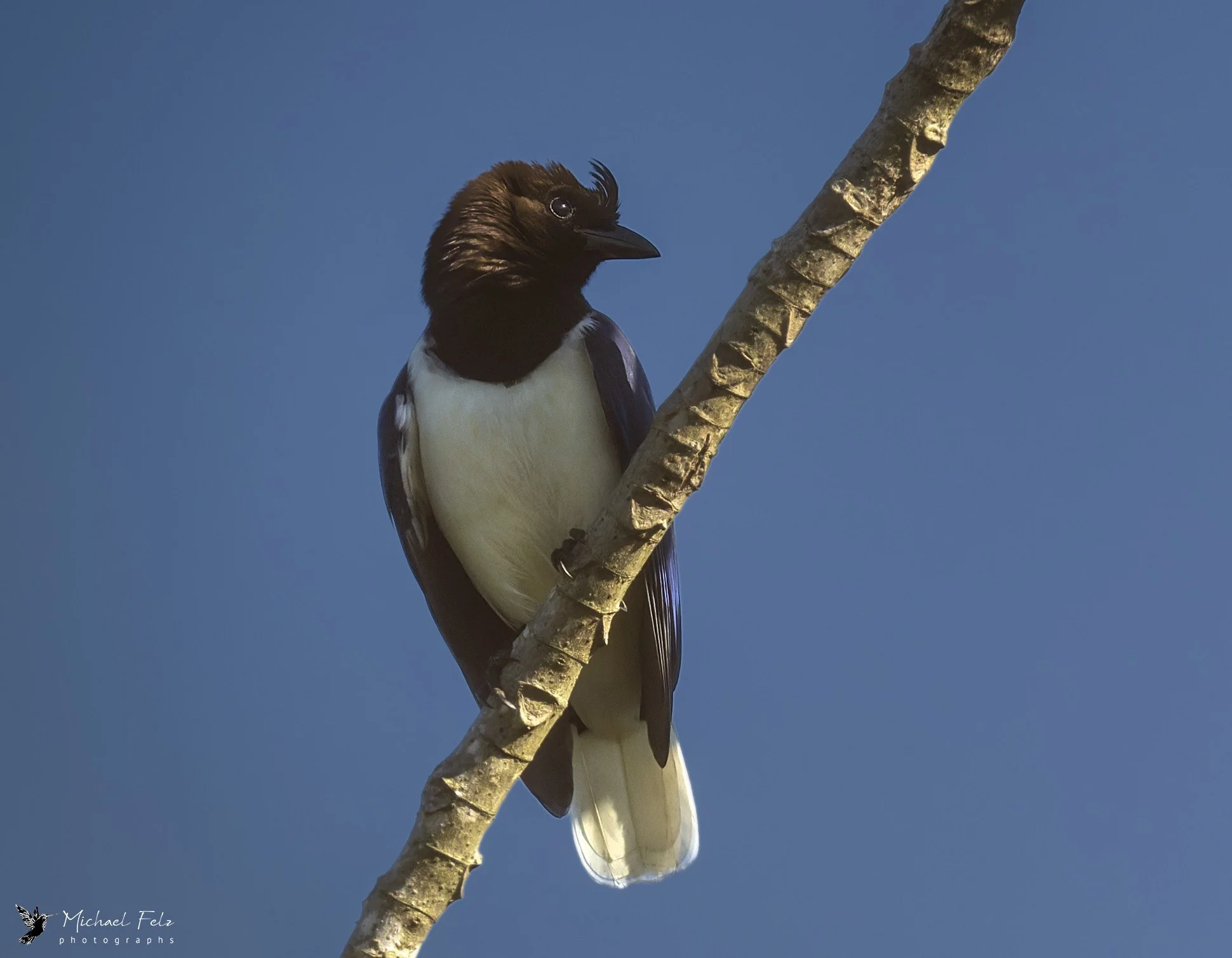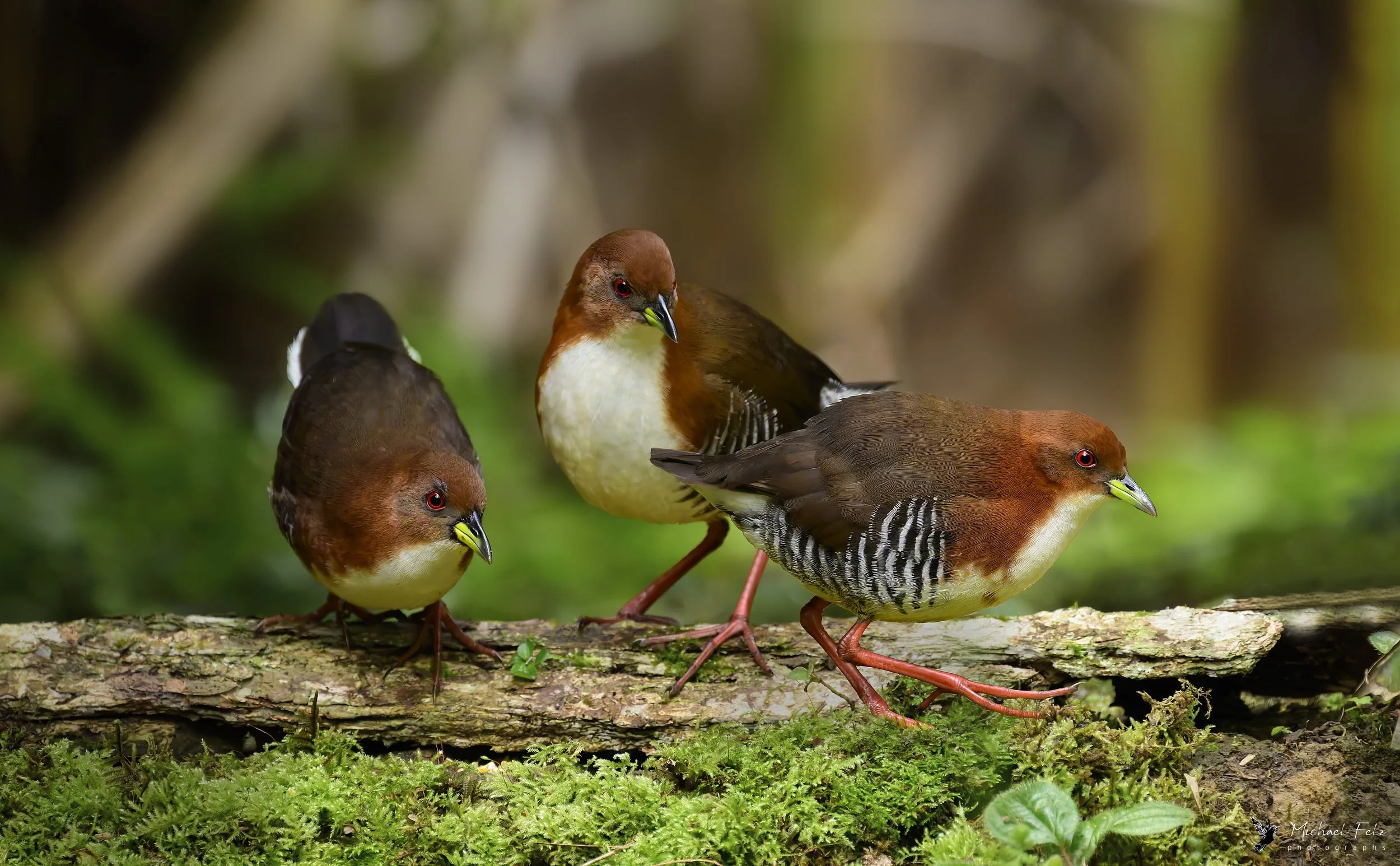
Brazil!
The Sharpbill (Oxyruncus cristatus) has no close relatives so is placed in its own family. As the name implies, it has a cone-shaped sharp bill and is greenish-yellow with white and black spots below. It has a rarely seen reddish-orange crest on top of its head (hence, the “cristatus” part of its scientific name). This one was on the grounds of the Hotel Donati lodge located within Brazil’s first national park, the Parque Nacional do Itatiaia.
his sweet little Bay-breasted Warbling Finch (Castanozoster thoracicus) is endemic to southern Brazil. Its habitat is at elevation (this one was at 2,130m). Its distinctive white eye patch is plainly seen in this photo while less evident is the reddish band around its breast and flanks.
For a bird that loves to perch at the forest’s edge, you’re bound to been seen and named a Roadside Hawk (Rupornis magnirostris). We saw this one on our way to Ninho da Cambacica Villa, a wonderful spot to photograph just north of Ubatuba, Brazil.
After a few wonderful rainy days at Ninho da Cambacica, we hit the road for destinations west of São Paulo. We came across this very handsome male Yellow-fronted Woodpecker (Melanerpes flavifrons) along the way to the coastal town of Ubatuba. Males have a red crown while females have a blue-black crown.
Southeast Brazil is such a nice place for bird photography that even when you stop for lunch you mustn’t forget your camera. Here’s a Plain Parakeet juvenile (Brotogeris tirica) sitting out the rain on a palm leaf just downhill from our picnic table.
Near the top of the list of entertaining birds, the Magpie Tanager is one of a kind as the only member of the genus Cissopis, but might be familiar to those in northern and western North America who are similarly entertained by the corvid Black-billed Magpies (Pica hudsonia). This Magpie Tanager was in the forest edge at Trilha dos Tucanos, near Tapiraí, SP Brazil.
This Curl-crested Jay (Cyanocorax cristatellus) was one of a small group on the outskirts of Itatiaia SP, Brazil, that showed up at an old petrol station when we stopped to photograph some Toco Toucans that we spotted along the road. The sun light just caught its eye.
I tried for a good long while to photograph this Sapphire-spangled Emerald in flight with its pinkish/reddish lower mandible showing - best I could get is this glimpse at the Sitio Macuquinho near Salesópolis, Brazil.
We found this wind-blown Rufous-fronted Thornbird (Phacellodomus rufifrons) near Brazil’s Parque Nacional do Itatiaia. It would have been nice to find its nest. The nests are built as long cylinders, often with thorny branches, and may be up to 6 feet long containing several “chambers”.
This male Violet-capped Woodnymph (Thalurania glaucopis) was photographed at Hotel Donati, located in the Parque Nacional do Itatiaia, located between Sao Paulo and Rio de Janeiro, Brazil.
The first project off the plane after 48 hours of travel and delays was (trying) to photograph Southern Yellowthroats (Geothlypis velata). Long considered a subspecies of the Masked Yellowthroat, now its own species, the Southern Yellowthroat hops and flits around very quickly close to the ground among grasses, cattails, and weeds. Its perches are seldom clean for photography. A nice challenge to start our trip to southeast Brazil!
Tanagers are distinguished by their vibrant, sexually dimorphic plumage, their fruit and insect diet, and their living in the forest canopy. The male Brazilian Tanager (Ramphocelus bresilius) is further distinguished by its vivid, rich red plumage. This one and its mate were visiting the Sitio Macuquinho Lodge in southeast Brazil.
The national bird of Brazil, the Rufous-bellied Thrush (Turdus rufiventris) is known for its beautiful song. It's memorialized in Antônio Gonçalves Dias' poem Canção do Exílio (Song in Exile), written while he was studying in Portugal: "My land has palm trees where the thrush sings. The birds that sing here do not sing as they do there. Our skies have more stars, our valleys have more flowers. Our forests have more life. Our lives have more love." The last two lines here are included in the Brazilian national anthem. This photo was taken one chilly morning at the beautiful Sitio Macuquinho Lodge.
This Cinnamon Tanager was photographed along the road through Brazil's Parque Nacional do Itatiaia, Brazil's first national park.
Streamer-tailed Tyrant, near Itatiaia
Toco Toucan, along the road to Pousada Salve Floresta
Slaty Bristlefront, Hotel Donati, Parque Nacional do Itatiaia
Black-goggled Tanager, with insect, Trilha dos Tucanos Lodge
White-spotted Woodpecker, Parque Nacional do Itatiaia
Black-goggled Tanager, reflection, Sitio Macaquinho Lodge
Saffron Toucanet, Trilha dos Tucanos Lodge
Saffron Toucanet, Trilha dos Tucanos Lodge
White-shouldered Fire-eye, Trilha dos Tucanos Lodge
Maroon-bellied Parakeet, Trilha dos Tucanos Lodge
Chestnut-bellied Euphonia, Trilha dos Tucanos Lodge
Magpie Tanager, Trilha dos Tucanos
Lesser Kisdadee, Pousada Salve Floresta Lodge
Cliff Flycatcher, Trilha dos Tucanos Lodge
Burrowing Owls, Ubatuba Bay
Blue Dacnis, male, Ninho da Cambacica Lodge
Blue Dacnis, female, Ninho da Cambacica Lodge
Hooded Berryeater, on the road to Ninho da Cambacica Lodge
Green Kingfisher, male, Sitio Macuquingo Lodge
Processing photos is sometimes art, sometimes science, and sometimes accident. This is the rare accident that I liked - a Streamer-tailed Tyrant near Itatiaia, Brazil.
We were fortunate to visit a narrow strip along Southeast Brazil’s Atlantic coast, on the edge of the tall forests, where the loud and beautiful Channel-billed Toucans (Ramphastos vitellinus) frequent. We observed them eating the plentiful palm nuts and other fruits, though evidently they’ll eat other birds, small lizards, frogs, etc. These were at Pousada Salve Floresta, a bit south and east of Sao Paulo.
The Red-and-white Crake (Rufirallus leucopyrrhus) has some color combinations that it can pull off with style. A marsh bird, this was the first of several new species for me that I photographed at Sitio Macuquinho near Salesopolis, Sao Paulo, Brazil. It has a partially greenish beak, red eyes, white breast, rufous head and neck, chestnut back, coral legs and feet, and distinctive white and black barred underfeathers.
The Blue Dacnis (Dacnis cayana) often frequent treetops looking for insects, though this rainy day they came down to check out a flower pot at Ninho da Cambacica. Here’s a male (bright blue with a black throat) and female (light green with a light blue crown).
Saw-billed Hermit, coming in out of the rain at Ninho da Cambacica
Endemic to Brazil, this Crescent-chested Puffbird (Malacoptila striata) was foraging along the forest edge on the grounds of Trilha dos Tucanos, near Sao Paulo. It has a distinctive black-banded white crescent on its upper breast, buff-colored arrow tips on its coverts, and a dark head with buff and rufous striations. It blends in well with its environment, so many thanks to our guide Hudson Martins Soares (www.birdsrio.com.br) for pointing it out.
Endemic to Brazil, this Crescent-chested Puffbird (Malacoptila striata) was foraging along the forest edge on the grounds of Trilha dos Tucanos, near Sao Paulo. It has a distinctive black-banded white crescent on its upper breast, buff-colored arrow tips on its coverts, and a dark head with buff and rufous striations. It blends in well with its environment, so many thanks to our guide Hudson Martins Soares (www.birdsrio.com.br) for pointing it out.
With a light green beak, slightly smaller size, and a habitat high in the mountain-side forests, the Red-breasted Toucan (Ramphastos dicolorus) is easily distinguished from the similar Channel-billed Toucan. Here’s one that our guide Hudson Martins Soares (www.birdsrio.com.br) found showing off its tomial teeth on the grounds of Trilha dos Tucanos, near Tapiraí, in the state of São Paulo, Brazil.
These Olive-green Tanagers were on the grounds of the Trilha dos Tucanos Lodge near Tapirai, west of Sao Paulo, Brazil. Endemic to Brazil, they are a olive-green/dull yellow above, with a darker crown and brighter yellow breast.
These Olive-green Tanagers were on the grounds of the Trilha dos Tucanos Lodge near Tapirai, west of Sao Paulo, Brazil. Endemic to Brazil, they are a olive-green/dull yellow above, with a darker crown and brighter yellow breast.
The Saw-billed Hermit (Ramphodon naevius) geographic range is confined to southeast Brazil. While it has somewhat drab coloring (the color of my college major’s tassel at graduation was “drab”, so I am a bit partial to drab), it has bold patterns and beautiful rufous/orange neck, cheeks, and tail feathers. And, almost discernible in my photo, a hooked beak tip.
We spent a few days at the beautiful Ninho da Cambacica Lodge west of Sao Paulo experiencing wonderful hospitality and meals while learning just how wet the rainforest can be! With covered decks high in the canopy, it was very comfortable observing many species in their natural habitat. Here are the sexually dimorphic male and female Green Honeycreepers (Chlorophanes spiza), both with distinctive red eyes and yellow slightly-curved beaks. The male is an almost turquoise blue with a black head, while the female is largely a yellow-ish green.
We spent a few days at the beautiful Ninho da Cambacica Lodge west of Sao Paulo experiencing wonderful hospitality and meals while learning just how wet the rainforest can be! With covered decks high in the canopy, it was very comfortable observing many species in their natural habitat. Here are the sexually dimorphic male and female Green Honeycreepers (Chlorophanes spiza), both with distinctive red eyes and yellow slightly-curved beaks. The male is an almost turquoise blue with a black head, while the female is largely a yellow-ish green.
Located down a winding, sometimes bumpy, road near Sao Paulo, the Pousada Salve Floresta property includes lush forests and a few small ponds that attract some of southeast Brazil’s most amazing birds. The beautiful Blond-crested Woodpeckers (Celeus flavescens) can be found there. Though their favorite diet is ants and termites found high in the canopy (they carve/drill new nests each year in arboreal ant or termite nests), they will come down for fruits, berries and insects on the ground, or maybe just to get their picture taken.















































